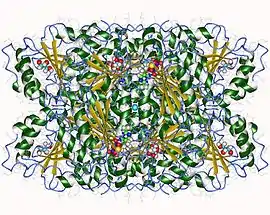Benzoylformate decarboxylase
In enzymology, a benzoylformate decarboxylase (EC 4.1.1.7) is an enzyme that catalyzes the following chemical reaction:
- benzoylformate + H+ benzaldehyde + CO2
| benzoylformate decarboxylase | |||||||||
|---|---|---|---|---|---|---|---|---|---|
 Benzoylformate decarboxlyase tetramer, Pseudomonas putida | |||||||||
| Identifiers | |||||||||
| EC number | 4.1.1.7 | ||||||||
| CAS number | 9025-00-7 | ||||||||
| Databases | |||||||||
| IntEnz | IntEnz view | ||||||||
| BRENDA | BRENDA entry | ||||||||
| ExPASy | NiceZyme view | ||||||||
| KEGG | KEGG entry | ||||||||
| MetaCyc | metabolic pathway | ||||||||
| PRIAM | profile | ||||||||
| PDB structures | RCSB PDB PDBe PDBsum | ||||||||
| Gene Ontology | AmiGO / QuickGO | ||||||||
| |||||||||
Hence, this enzyme has one substrate, benzoylformate, and two products, benzaldehyde and CO2.
This enzyme belongs to the family of lyases, specifically the carboxy-lyases, which cleave carbon-carbon bonds. The systematic name of this enzyme class is benzoylformate carboxy-lyase (benzaldehyde-forming). Other names in common use include phenylglyoxylate decarboxylase, and benzoylformate carboxy-lyase. This enzyme participates in benzoate degradation via hydroxylation and toluene and xylene degradation. It employs one cofactor, thiamin diphosphate.
Structural studies
As of late 2007, 8 structures have been solved for this class of enzymes, with PDB accession codes 1BFD, 1MCZ, 1PI3, 1PO7, 1Q6Z, 1YNO, 2FN3, and 2FWN.
References
- GUNSALUS CF, STANIER RY, GUNSALUS IC (1953). "The enzymatic conversion of mandelic acid to benzoic acid. III Fractionation and properties of the soluble enzymes". J. Bacteriol. 66 (5): 548–53. doi:10.1128/JB.66.5.548-553.1953. PMC 317432. PMID 13108854.